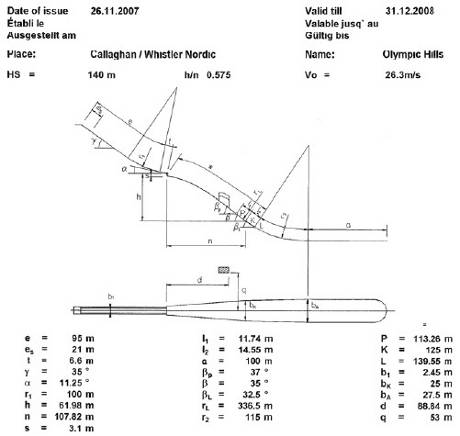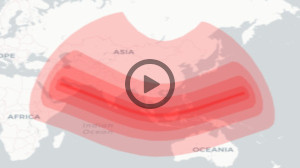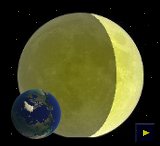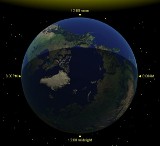|
|
This blog is part of unitarium.com site where you can find
unit converters, calculators and other information focused on units of measurement. See menu on the left.
Posts Tagged ‘vancouver 2010’
Saturday, February 13th, 2010
Simon Ammann won the gold Olympic Medal on HS106 ski jumping hill in Vancouver. He jumped 108m (118.1yd, 354.3ft). This is new hill record. Previous was set by Guido Landert and it was 105 meters (344.49ft)
1. Simon Ammann Swiss 105m (344.49ft) 135.5 108m (354.3ft) 141 276.50
2. Adam Małysz Poland 103.5m (339.57ft) 132.5 105m (344.49ft) 137 269.50
3. Gregor Schlierenzauer Austria 101.5m (333.01ft)128 106.5m (349.41) 140 268.00
Tags: length, ski, vancouver 2010
Posted in Articles | Comments Off on Simon Ammann 108m
Tuesday, February 9th, 2010
The tables below lists Vancouver sports events distances in kilometers, meters, miles, yards and feet. Click the link to go to length converter online and get more conversion units.
Vancouver Men’s Sports Distances Conversion Table
| Event |
Kilometers |
Meters |
Miles |
Yards |
Feet |
| Biathlon |
| Relay |
4×7.5km |
4×7,500 |
4×4.66 |
4×8,202 |
4×24,606 |
| Sprint |
10km |
10,000 |
6.21 |
10,936 |
32,808 |
| Pursuit |
12.5km |
12,500 |
7.77 |
13,670 |
41,010 |
| Mass Start |
15km |
15,000 |
9.32 |
16,404 |
49,212 |
| Individual |
20km |
20,000 |
12.43 |
21,872 |
65,617 |
| Cross-country skiing |
| Freestyle |
15km |
15,000 |
9.32 |
16,404 |
49,212 |
| Pursuit |
30km |
30,000 |
18.64 |
32,808 |
98,425 |
| Classical |
50km |
50,000 |
31.07 |
54,681 |
164,042 |
| Relay |
4x10km |
4×10,000 |
4×6.21 |
4×10,936 |
4×32,808 |
| Short Track |
|
0.5km |
500 |
0.31 |
547 |
1,640 |
|
1km |
1,000 |
0.62 |
1,094 |
3,281 |
|
1.5km |
1,500 |
0.93 |
1,640 |
4,921 |
|
5km |
5,000 |
3.11 |
5,468 |
16,404 |
| Speed Skating |
|
0.5km |
500 |
0.31 |
547 |
1,640 |
|
1km |
1,000 |
0.62 |
1,094 |
3,281 |
|
1.5km |
1,500 |
0.93 |
1,640 |
4,921 |
|
5km |
5,000 |
3.11 |
5,468 |
16,404 |
|
10km |
10,000 |
6.21 |
10,936 |
32,808 |
Vancouver Womens’s Sports Distances Conversion Table
| Event |
Kilometers |
Meters |
Miles |
Yards |
Feet |
| Biathlon |
| Relay |
4×6 km |
4×6000 |
4×3.73 |
4×6,562 |
4×19,685 |
| Sprint |
7.5 km |
7,500 |
4.66 |
8,202 |
24,606 |
| Pursuit |
10 km |
10,000 |
6.21 |
10,936 |
32,808 |
| Mass Start |
12.5 km |
12,500 |
7.77 |
13,670 |
41,010 |
| Individual |
15 km |
15,000 |
9.32 |
16,404 |
49,212 |
| Cross-country skiing |
| Freestyle |
10 km |
10,000 |
6.21 |
10,936 |
32,808 |
| Pursuit |
15 km |
15,000 |
9.32 |
16,404 |
49,212 |
| Classical |
30 km |
30,000 |
18.64 |
32,808 |
98,425 |
| Relay |
4×5 km |
4×5,000 |
4×3.11 |
4×5,468 |
4×16,404 |
| Short Track |
|
0.5 km |
500 |
0.31 |
547 |
1,640 |
|
1 km |
1,000 |
0.62 |
1,094 |
3,281 |
|
1.5 km |
1,500 |
0.93 |
1,640 |
4,921 |
|
3 km |
3,000 |
1.86 |
3281 |
9843 |
| Speed Skating |
|
0.5 km |
500 |
0.31 |
547 |
1,640 |
|
1 km |
1,000 |
0.62 |
1,094 |
3,281 |
|
1.5 km |
1,500 |
0.93 |
1,640 |
4,921 |
|
3 km |
3,000 |
1.86 |
3281 |
9843 |
|
5 km |
5,000 |
3.11 |
5,468 |
16,404 |
Tools: Distance Conversion Online
Tags: length, sport, vancouver 2010
Posted in Articles | Comments Off on Vancouver Sports Events Distances
Monday, February 8th, 2010
There are two ski jumping hills in the Vancouver’s Whistler Olympic Park – Large Hill (LH HS140/K125) and Normal Hill (NH HS106/K95). Technical data and the hill records (given in meters and feet) are available in the tables below.
| Whistler Olympic Large Hill HS140 (K125) |
| Hill Record |
149.0m (488.85ft)
Gregor Schlierenzauer 2009-01-25 |
| Hill Size |
140m (459.32ft) |
| K-point |
125m (410.1ft) |
| Takeoff gradient |
11.25° |
| Landing gradient |
35.0° |
| Construction year |
2007 |
| Spectator capacity |
10,000 |
| Whistler Olympic Normal Hill HS106 (K95) |
| Hill Record |
105.0m (344.49ft)
Guido Landert 2008-02-28 |
| Hill Size |
106m (347.77ft) |
| K-point |
95m (311.68ft) |
| Takeoff gradient |
11.0° |
| Landing gradient |
34.0° |
| Construction year |
2007 |
| Spectator capacity |
10,000 |
Source: fisskijumping.com
HillSize (HS) – distance between take-off and landing field where the gradient is equal to 32.5° (see: L-point on the image below)
K-point (calculation line or calculation point) – Skiers are awarded 60 points if they land on the K Line. Skiers not landing on the K Line receive or lose points for every metre (3 ft) they miss the mark by, depending on if they surpass it or fall short, respectively. The value of a meter is determined from the size of the hill.
How K-point and HillSize are calculated, see the image below
(source: Whistler 140 Profile)

Useful tools: Length Converter
Tags: length, ski, sport, vancouver 2010
Posted in Articles | Comments Off on Vancouver Ski Jumping Hills
Monday, February 8th, 2010
It should be obvious that the maximum and average speed in downhill skiing strongly depends on the course racer runs on. On a typical FIS-approved, international-level course racers can run about 130 km/h (80mph) but some courses can be faster. For example, in certain sections of “Streif” course in Kitzbühel, Austria racers can run up to 140 kilometers per hour (87 miles per hour) (Course Start at 1.665m/5462.6ft, finish 805m/2641.08ft, vertical drop 860m/2821.52ft, length 3.312m/10866.14ft, average gradient 27%, maximum gradient 85%, minimum gradient 2%)
Right from the start, racers require a great deal of courage and self-confidence to fully charge the course, launching off to jumps of 50 m to 80 m at the sharp edge into Mausefalle. The Compression following Mausefalle has proved fatal to many a favorite in his struggle to resist the tremendous forces acting on him. (Source: hahnenkamm.com)
Vancouver 2010 downhill men will run February 13th, 2010 on Dave Murray downhill track in Whistler Creek (length 3158m, vertical drop 853m, maximum gradient 47%, average gradient 28% Source:scribd.com )
Speed skiing
Speed skiing is the sport of skiing downhill in a straight line as quickly as possible. It is one of the fastest non-motorized sports on land … The current world record is 251.4 km/h (156 mph), held by Simone Origone. Speed skiers regularly exceed 200 km/h (125 mph), which is even faster than the terminal velocity of a free-falling skydiver; about 193 km/h (120 mph) in the belly-to-earth position
Speed skiing official world records
Men: Simone Origone, Italy – 251.4 km/h (156.2 mph), April 2006 Les Arcs, France
Women: Sanna Tidstrand, Sweden – 242.59 km/h (150.74 mph), April 2006 Les Arcs, France
Useful tools: Speed Converter, Length Converter
Tags: ski, speed, sport, vancouver 2010
Posted in Articles | Comments Off on Downhill skiing speed
|



